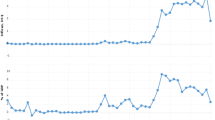Abstract
While it has long been recognised that the process of development is necessarily linked to technology, the question of the efficiency of technological spillovers from foreign direct investment remains controversial. The following paper examines the theoretical background and then focuses on the case of Mexico, analysing the technological performance of multinational enterprises in that country.
Similar content being viewed by others
References
M. V. Posner: International trade and technical change, Oxford Economic Papers, 1961, No. 13, pp. 323–341; R. Vernon: International investment and international trade in the product cycle, in: Quarterly Journal of Economics, 1966, No. 80, pp. 253–266; S. Hirsch: Location of Industry and International Competitiveness, Oxford 1967.
See e.g. G. Dosi, K. Pavitt and L. Soete: The economics of technical change and international trade, London, New York 1990, pp. 200 ff.; G. M. Grossman and E. Helpman: Innovation and growth in a global economy, London 1991.
J. Cantwell: Transnational corporations and innovatory activities, in: UNCTAD (ed.): Transnational corporations and world development, London, Bonn 1996, pp. 145–180.
ISI (Fraunhofer-Institut für Systemtechnik und Innovationsforschung) /IMI (Forschungsstelle Internationales Management und Innovation): Globales Management von Forschung und Innovation, Bonn 1996, mimeo.
E. K. Chen: Transnational corporations and technology transfer to developing countries, in: UNCTAD (ed.), op. cit., Transnational corporations and world development, London, Bonn 1996, pp. 181–215, here pp. 186 ff.
S. Lall: Building industrial competitiveness in developing countries, Paris 1990.
A. Goto and K. Suzuki: R&D capital, rate of return of R&D investment and spillover of R&D in Japanese manufacturing industries, in: The Review of Economics and Statistics, 1989, Vol. 71, pp. 555–564.
S. H. Hymer: The international operations of national firms: A study on direct investment, dissertation, MIT 1960, pp. 48 ff.
J. H. Dunning: Trade, location of economic activity and MNE: A search for an eclectic approach, in: B. Ohlin (ed.): The international allocation of economic activity, London, Basingsstoke 1977, pp. 395–418; J. R. Markusen and J. R. Melvin: The theory of international trade, New York, Cambridge 1988, pp. 303 ff.
M. Kamien and N. Schwartz: Market structure and innovation, Cambridge 1982, p. 2; G. Akerlof: The market for “lemons”: Quality uncertainty and the market mechanism, in: Quarterly Journal of Economics, 1970, Vol. 84, pp. 488–504.
R. H. Coase: The nature of the firm, in: Economica, 1937, pp. 386–405; O. E. Williamson: The economic institution of capitalism, New York, London 1985.
E. Mansfield and A. Romeo: Technology transfer to overseas subsidiaries by U.S.-based firms, in: Quarterly Journal of Economics, 1980, Vol. 95, pp. 737–750; J.-Y. Wang and M. Blomström: Foreign investment and technology transfer—a simple model, in: European Economic Review, 1992, Vol. 36, pp. 137–155.
W. M. Cohen and D. A. Levinthal: Innovation and learning: the two faces of R&D, in: The Economic Journal, September 1989, Vol. 99, pp. 569–596.
IMF: How does FDI affect economic growth?, Washington 1994.
J.-Y. Wang and M. Blomström, op. cit., Foreign investment and technology transfer—a simple model, in: European Economic Review, 1992, Vol. 36, pp. 141 ff.
B. Burger: Ausländische Direktinvestitionen, technologische Spillover-Effekte und industrielle Entwicklung, dargestellt am Beispiel Mexiko, Baden-Baden 1998, pp. 65 ff.
D. J. Teece: The multinational corporation and the resource cost of international technology transfer, Cambridge, Massachusetts 1977, p. 46.
G. Dosi, K. Pavitt and L. Soete, op. cit., The economics of technical change and international trade, London, New York 1990, p. 158.
For example, OECD: Structural adjustment and economic performance, Paris 1987, pp. 18ff.; D. Ernstand, D. O'Connor: Technology and global competition: The challenge for newly industrialising economies, Paris 1989, pp. 48 f.
B. Burger, op. cit., Ausländische Direktinvestitionen, technologische Spillover-Effekte und industrielle Entwicklung, dargestellt am Beispiel Mexiko, Baden-Baden 1998, pp. 67 ff.
F. M. Scherer: Innovation and growth: Schumpeterian perspective, Cambridge 1984, p. 127.
See e.g. D. North: Institutional change and economic performance, Cambridge 1990, pp. 4 ff.
For a general discussion see M. Fritsch, T. Wein and H.-J. Ewers: Marktversagen und Wirtschaftspolitik, Munich 1993, pp. 70 ff.
In a general context D. J. Lecraw and A. Morrison: Transnational corporations—host country relations: A framework for analysis, Essays in International Business, South Carolina 1991; R. Grosse: The bargaining relationship between global companies and national governments, Miami 1991.
SECOFI (Secretaria de Comericio y Fomento Industrial), 1996, information material given to the author; UNCTAD: World investment report 1996—Investment, trade and international policy arrangements, New York 1996, p. 8; A. Calderón, M. Mortimore and W. Peres: Mexico's incorporation into the new industrial order: Foreign investment as a source of international competitiveness, in: United Nations: Desarrollo Productivo, No. 21, Santiago de Chile 1995, p. 37.
Expansíon: Las 500 empresas más importantes de México, Mexico City, August 1995.
OECD: Science, technology and industry outlook, Paris 1996.
B. Burger, op. cit. Ausländische Direktinvestitionen, technologische Spillover-Effekte und industrielle Entwicklung, dargestellt am Beispiel Mexiko, Baden-Baden 1998 pp. 138ff.
T. Huss: Foreign direct investment and industrial restructuring in Mexico, UNCTC Current Studies, No. 18, New York 1992.
B. Burger, op. cit., Ausländische Direktinvestitionen, technologische Spillover-Effekte und industrielle Entwicklung, dargestellt am Beispiel Mexiko, Baden-Baden 1998, pp. 145 f.; for older data see F. Fajnzylber, and T. Martínez: Las empresas transnacionales, Mexico City 1987.
M. Blomström: Foreign investment and spillovers, London, New York 1989; M. Blomström and H. Persson: Foreign investment and spillover efficiency in an underdeveloped economy: Evidence from the Mexican manufacturing industry, in: World Development, 1983, Vol. 11, No. 6, pp. 493–501.
K. Unger: Competencia monopólica y tecnología en la industria mexicana, Mexico City 1985.
C. Ruiz: The role of Japanese direct investment in developing countries: The case of Mexico, in: Institute of Developing Economies (ed.): The role of Japanese direct investment in developing countries, Tokyo 1995, pp. 164–267.
B. Burger, op. cit., Ausländische Diretinvestitionen, technologische Spillover-Effekte und industrielle Entwicklung, dargestellt am Beispiel Mexiko, Baden-Baden 1998, pp. 153 ff.
Author information
Authors and Affiliations
Additional information
This paper expresses the personal opinion of the author.
Rights and permissions
About this article
Cite this article
Burger, B. How important is foreign direct investment for late industrialising countries?. Intereconomics 34, 115–123 (1999). https://doi.org/10.1007/BF02930163
Issue Date:
DOI: https://doi.org/10.1007/BF02930163




